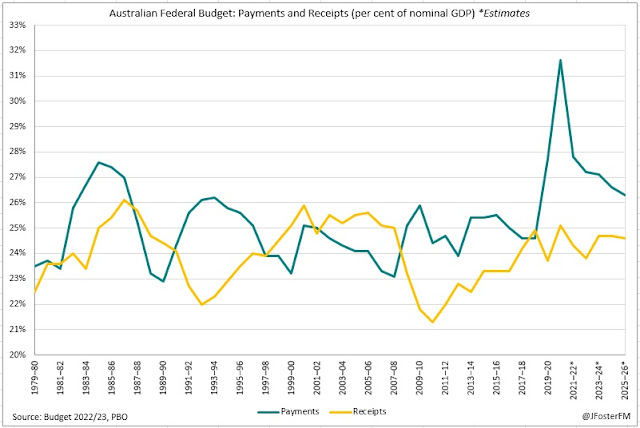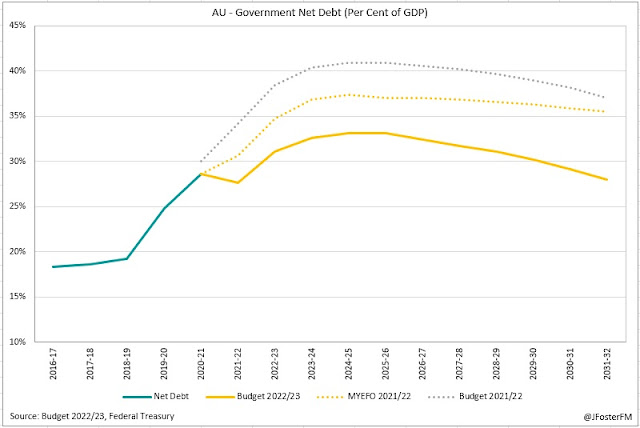The Australian Federal Budget 2022/23 capitalises on the resilience and pace of the economic recovery, with the government using a windfall in revenue to fund additional stimulus measures that are targeted at cost of living pressures in the near term and on boosting potential growth over the medium term in the lead up to this year's election.
Federal Budget 2022/23 | Budget Position
Since the outset of the pandemic, Australia's economic recovery has outperformed expectations and this has driven an improved fiscal position over successive budgets. This trend has continued with the deficits forecast in the December MYEFO now expected to be smaller.
In the current financial year, the deficit has been revised from $99.2bn (4.5% of GDP) to $79.8bn (3.5% of GDP), and in 2022/23 the deficit has improved from $98.9bn (4.4% of GDP) to $78bn (3.4% of GDP). Over the 4 years from 2022/23 to 2025/26, the cumulative deficit has fallen from $309bn to $225bn.
With the economy expanding to more than 3% above its pre-pandemic level of GDP and the unemployment rate at its lowest since 2008 and projected to keep declining to levels last seen in the 1970s, the recovery phase has been secured. The government's fiscal strategy now sees fiscal support gradually being withdrawn as the focus turns to medium-term objectives to boost growth and stabilise debt. This focus results in lower deficits across the out-years to $56.5bn in 2023/24 (from $84.5bn), $47.1bn 2024/25 (from $57.5bn) and $43.1bn in 2025/26 (from $68.1bn).
In this pre-election budget, a stronger economy has provided the government with a windfall of $28.3bn over the remainder of 2021/22 and $38.1bn in 2022/23. The Treasurer has used this to fund new stimulus that costs the budget $26bn over this period, of which $8.9bn is in the remainder of 2021/22 and $17.2bn in 2022/23, centred on cost of living support, while the remainder is used to lower debt.
Highlighting the change in the government's fiscal strategy, the cumulative effect on the budget from a stronger economy is $114.6bn between 2022/23 and 2025/26 while new stimulus costs $30.4bn over the period.
Federal Budget 2022/23 | Policy Measures
The major measures announced in the budget are summarised in the table below. The focus is around providing cost of living support as pandemic-related spending continues in the near term. The focus switches to infrastructure and skills in the later years.
On the payments side, new measures announced will cost the budget $8.8bn in 2022/23 and $31.5bn out to 2025/26. The highlights are:
- In April 2022, welfare recipients will receive a once-off $250 payment to ease cost of living pressures.
- An additional $2.1bn of health-related spending in response to Covid-19 in 2022/23 spread across the provision of Rapid Antigen Tests, hospital spending, Medicare and aged care.
- A $1.2bn package in 2022/23 to support the recoveries of flooded communities in New South Wales and Queensland, centred on additional payments and support services for impacted residents.
- New and expanded listings to the PBS will provide a $0.7bn subsidy for medicines in 2022/23 and $2.4bn out to 2025/26.
- State and territory infrastructure investment is boosted by a further $3.6bn over the forward estimates.
- Investment of $2.7bn out to 2025/26 in a new National Skills Agreement that will aim to identify and develop key skills needed to drive economic growth.
- A new 'Regional Accelerator Program' aims to boost investment in regional areas by $1.8bn over the next 5 years by enhancing infrastructure, manufacturing, skills and training and education.
- A $1.5bn package supporting the government's wage subsidy scheme for new apprentices.
Government receipts are lowered by $8.4bn in 2022/23 to provide cost of living support for Australians. The key measures are:
- Cost of Living Tax Offset: The low and middle income tax offset will be increased by $420 for the 2021/22 income year. This increases the maximum tax offset available to individuals, from $1,080 to $1,500, and to couples, from $2,580 to $3,000.
- Reduction in fuel excise: Starting from 30 March, the government will for a period of 6 months (ending 28 September 2022) cut the fuel excise from 44.2 cents per litre to 22.1 cents per litre.
- Small business support: tax incentives to enhance spending on training and technology.
Federal Budget 2022/23 | Payments and Receipts
The pandemic stimulus response saw government payments as a share of GDP rising from a pre-crisis level of around 24.5% to a peak of 31.6% in 2020/21. Payments then eased 27.8% of GDP in 2021/22 and are forecast to remain on a declining trajectory, from 27.2% in 2022/23 to 26.3% in 2025/26.
A stronger-than-expected economy has driven an upward revision to government receipts since MYEFO. The measures in this Budget see receipts decline from 24.3% to 23.8% of GDP in 2022/23, though in MYEFO weaker economic conditions had pointed to a larger fall to 23.1% of GDP. In 2023/24, receipts are anticipated to rise to 24.7% of GDP (up from 23.6% in MYEFO) and remain around that level over the out-years.
Government debt
The profile for government net debt has improved further since the December MYEFO due to higher government revenues generated by a stronger economy. Net debt falls from 28.6% of GDP in 2020/21 to 27.6% in 2021/22, whereas it was forecast to rise in MYEFO to 30.6%.
As a result of the new measures in this budget, net debt moves back up again in 2022/23 to 31.1% of GDP, though that is lower than the rise forecast in MYEFO to 34.7% of GDP. Accordingly, the government's borrowing requirement for 2022/23 is lower than earlier anticipated, with the AOFM announcing expected issuance of around $125bn for the financial year.
Net debt then moves gradually higher to peak at 33.1% of GDP in 2025/26, revised down from 37.4% of GDP in 2024/25 in MYEFO. The trajectory of net debt is then lower across the projections compared to MYEFO.
Federal Budget 2022/23 | Economic Outlook
Australia's economic recovery has outperformed expectations since the onset of the pandemic and this trend has continued. As result, the economic forecasts in the budget have been upgraded.
For 2021/22, GDP growth has been revised up from 3.75% in MYEFO to 4.25%. Activity expands by 3.5% in 2022/23 (unchanged from MYEFO) and returns to its pre-pandemic trajectory in the process. Growth then moderates to an around trend pace over the out-years.
The rise in the unemployment rate to 4.7% in Q4 following the reopening from the Delta lockdowns was much smaller than expected in MYEFO (5.25%) and a stronger-than-expected economy has then supported a faster tightening in the labour market. The unemployment rate is expected to average 4% by Q2 2022, down from 4.25% previously. Further progress is made over the following year to reach 3.75% by mid-2023 compared to 4.25% in MYEFO.
Faster wages growth flows from a tighter labour market. Growth in the Wage Price Index has been revised up to 2.75% in 2021/22 from 2.25%. However, that is more than outpaced by the rise in inflation to 4.25%, upgraded substantially from 2.75% in MYEFO on the back of the spillover effects of the Ukraine war and global supply chain pressures. This highlights the intent of the government to provide near-term cost of living support.
In 2022/23 and 2023/24, wages growth advances to 3.25% (up from 2.75% and 3% respectively) as inflation moderates to 3% in 2022/23 and to 2.75% in 2023/24. Wages growth firms to peak at 3.5% in 2024/25, up from 3.25% previously.
National income is boosted by the stronger labour market, faster wages growth and elevated commodity prices. Nominal GDP growth is expected to rise by 10.75% in 2021/22 compared to 6.5% forecast in MYEFO. The terms of trade are up by 11% on this comparison. The key assumption on the iron ore price is that the current price of around US$130/t will decline to US$55/t by the end of the September quarter, one quarter later than earlier assumed, though given the Ukraine war this is a conservative outlook. As a result, nominal GDP slows to 0.5% in 2022/23, with the terms of trade unwinding by 21.25% over the year.
In the global economy, the headwinds from the Ukraine war and high inflation have led to downgrades to the growth outlook in 2022. Global GDP growth has been revised from 4.5% at the time of MYEFO to 3.75% on the back of 0.75pp downgrades in the US (to 3.5%) and euro area (to 3.5%), while growth in China slows by 0.25pp to 4.75% this year.
Federal Budget 2022/23 | Summary
The budget position has continued to be boosted by the strength of Australia's economic recovery. This has provided the government with scope for additional stimulus to keep the momentum rolling as headwinds from higher inflation and increased uncertainty offshore build. Notwithstanding these headwinds, Australia's economic outlook remains robust, with GDP growth forecast to rise at a well above trend pace this financial year and next and an unemployment rate anticipated to fall to 50-year lows.










